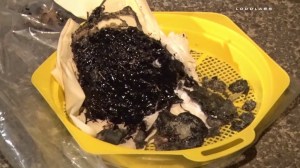Officials on Thursday were investigating the origin of “tar balls” that washed ashore in Long Beach the previous day, closing a 4-mile stretch of the coastline.

Samples will be tested by representatives from the U.S. Coast Guard in an effort to determine where the oily substance coming from, Long Beach Fire Department Chief Mike DuRee said.
DuRee does not believe it is coming from any of the Long Beach oil drilling operations.
“All of our oil islands, near shore oil islands, were inspected yesterday. There were no signs of leaks whatsoever. We believe that none of this product is a result of any of the Long Beach Gas and Oil operations,” DuRee said.
Although crews worked overnight to clean the beach, the stretch of coastline from 1st Place through 72nd Place would remain closed indefinitely, according to DuRee.
“As the tide comes in we’re starting to see more product come up on our beach … We won’t open it until we know it’s safe,” DuRee said.
Officials said at least two animals have been impacted by the mysterious tar balls.
A California brown pelican that was saturated with oil has been rescued and is being treated, Jake Heflin of the Fire Department said during a news conference Thursday.
A sea lion was also sighted on the breakwater, but rescuers were unable to capture it, Heflin said.
It was still unclear if there was any link between the Santa Barbara oil spill near Refugio State Beach and the recent incidents involving tar balls off Southland beaches.
More video:















